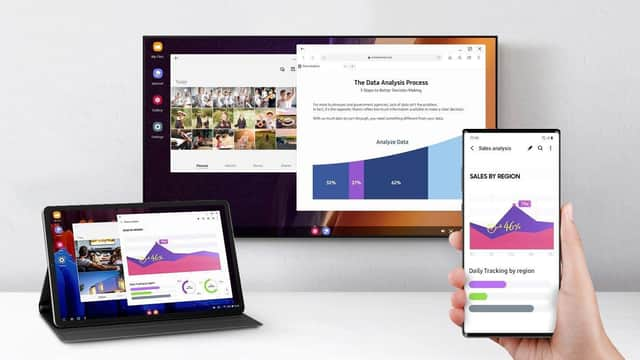Getting the best desktop experience from your phone and laptop


Conducting video conferences is a particular nightmare if you’re reduced to doing so on a small screen. Hooking up your TV is a better option, but compatibility is limited and the process typically involves as much wiring as a medium-sized Christmas tree.
It has taken a year of remote working for the big electronics companies to come up with something better. Finally, a “desktop experience” on a mobile phone is within reach.
Advertisement
Hide AdAdvertisement
Hide AdSamsung and Motorola are among the first to introduce proprietary systems which let you plug your smartphone into a computer monitor, TV, or any other HDMI-compatible screen, and send video streams to the larger display.
For the companies involved, there is sound logic to this, since connectivity is guaranteed only between their own devices, and top-of-the-range models at that. So it may be the sort of investment you’d want your boss to bankroll, rather than hand over cash of your own for a system which may yet be transient. Nevertheless, it’s a step in the right direction.
Samsung’s desktop experience software, which it calls DeX for short, allows the connection of a keyboard, mouse, and monitor to a top-end phone. The original configuration required a separate hub to hook them all up, but Samsung now says it can be done wirelessly, depending on the type of TV you have. Not only Zoom meetings but also your word processor and business applications can be displayed and edited on the big screen, with your phone serving as a touch-screen remote control for the TV. Transferring files between devices is also supported – but there are still many caveats, so check the small print before parting with any cash.
Motorola’s Ready For system is similar, though it relies on a cable to patch your phone to a large monitor or TV screen – which you then can use to check your email and all the other tasks you might struggle to do on a smaller display. For video calls, Ready For shows the other people you’re calling on your TV, while harnessing your phone camera to let them see a tightly-cropped shot of your face, even if you stand up and move around the room. You can also use it to stream video from Netflix in ultra high-definition, whether or not your phone alone supports it, and play games by using your handset as a mini console.
Advertisement
Hide AdAdvertisement
Hide AdHuawei has gone some way down the same route with a method it calls Easy Projection, and it won’t be long before other makers follow suit. But if you don’t want to tie yourself to a single brand, there are a few old tricks that make it possible to achieve an office-like experience at home. The simplest of these is to run a cable from your laptop to either a TV or PC monitor, and to plug in an external keyboard and mouse while you’re at it. It takes only a few seconds to unplug them all at the end of the day if you don’t want to take your work home with you.
You can also mirror your phone’s screen to your TV for viewing presentations from the comfort of a sofa. This works with most handsets and smart TVs, as well as plug-in devices like Chromecast and Roku sticks. It’s not a fully streamlined solution but it’s more ergonomic than a laptop alone, and cheaper than a complete desktop experience.
Support The Yorkshire Post and become a subscriber today. Your subscription will help us to continue to bring quality news to the people of Yorkshire. In return, you’ll see fewer ads on site, get free access to our app and receive exclusive members-only offers. Click here to subscribe.
Comment Guidelines
National World encourages reader discussion on our stories. User feedback, insights and back-and-forth exchanges add a rich layer of context to reporting. Please review our Community Guidelines before commenting.